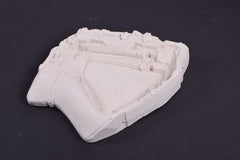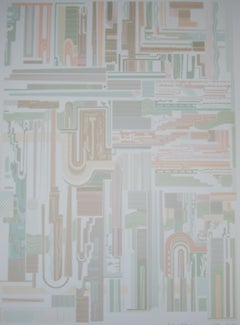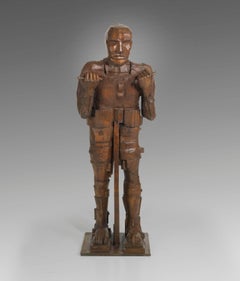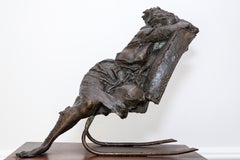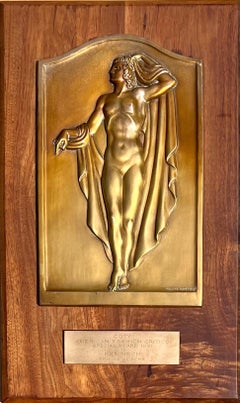Sir Eduardo Paolozzi Art
to
3
1
1
1
1
2
1
1
Overall Height
to
Overall Width
to
2
1
1
1
1
1
1
1
4
1
2
4
6,998
3,352
2,513
1,213
1
1
1
1
1
Artist: Sir Eduardo Paolozzi
Eduardo Paolozzi: Amphitheatre plaster sculpture
By Sir Eduardo Paolozzi
Located in London, GB
To see our other Modern British Art, scroll down to "More from this Seller" and below it click on "See all from this Seller" - or send us a message if you cannot find the artist you ...
Category
1990s Sir Eduardo Paolozzi Art
Materials
Plaster
Sir Eduardo Paolozzi industrial drawings, (2 drawings), 20th Century, Scottish
By Sir Eduardo Paolozzi
Located in Petworth, West Sussex
Sir Eduardo Luigi Paolozzi CBE RA (Scottish, 1924 – 2005)
Industrial abstract; and another similar
Pencil, crayon and ink on paper
8 x 11.1/2 in. (20.3 x 29 cm.) (both)
Category
20th Century Abstract Geometric Sir Eduardo Paolozzi Art
Materials
Paper, Crayon, Ink, Pencil
Hors Concours
By Sir Eduardo Paolozzi
Located in New York, NY
Hors Concours, 1974
screenprint
98 3/4 x 30 inches
edition of 70
Eduardo Paolozzi was born in Edinburgh, Scotland in 1924. Because his parents were Italian immigrants, Paolozzi was ...
Category
1970s Abstract Sir Eduardo Paolozzi Art
Materials
Screen
Daedalus
By Sir Eduardo Paolozzi
Located in London, GB
Signed, dated twice & inscribed 'Unikat' verso
Cast at Arch Bronze Foundry, London in 1990
Five slightly varying versions recorded, this unique work was the first one
Category
1990s Modern Sir Eduardo Paolozzi Art
Materials
Bronze
Related Items
Figure of a Woman Sleeping in a Rocking Chair by Bruno Lucchesi
By Bruno Lucchesi
Located in Brookville, NY
This bronze sculpture of a woman in a chair, is typical of the work of Bruno Lucchese. Born in Italy in 1926, Bruno Lucchesi has been referred to as “the last of the Renaissance scu...
Category
1960s American Modern Sir Eduardo Paolozzi Art
Materials
Bronze
H 18 in W 9 in D 16 in
1961 Coty Award Plaque Kenneth Hairdresser Jacqueline Onassis Bronze Fashion
Located in New York, NY
1961 Coty Award Plaque Kenneth Hairdresser Jacqueline Onassis Bronze Fashion
Bronze on wood. The wood plaque measures 12 3/4" by 20 3/4 inches. The bronze plaque itself is 13 3/4 x 8 3/4 inches and the the bronze inscription, which reads "COTY, American Fashion Critics Special Award 1961 to KENNETH of LILY DACHE...
Category
1960s American Modern Sir Eduardo Paolozzi Art
Materials
Bronze
After Alberto Giacometti, Man Standing Up, Bronze Figure
By Alberto Giacometti
Located in Pasadena, CA
Modern bronze with gold patina figural sculpture, in the style of Alberto Giacometti (Swiss, 1901-1966), not signed, depicting abstract nude male a figures, in a parcel gilt finish, ...
Category
1950s Modern Sir Eduardo Paolozzi Art
Materials
Bronze
Mexican Art Abstract Brutalist Biomorphic Bronze Sculpture Mathias Goeritz
By Mathias Goeritz
Located in Surfside, FL
Mathias Goeritz (German Mexican, 1915-1990)
Bronze sculpture
Signed and numbered
Dimensions: (approximate) Height: 10 inches, Width: 4 inches, Depth: 2 inches.
This is a cast bronze sculpture in an amorphous figure shape, quite heavy. Reminiscent of the biomorphic sculpture of Hans Jean Arp. This came from an estate and bears his signature It is not dated. there is no accompanying documentation. it is priced accordingly.
Werner Mathias Goeritz Brunner (Danzig, Germany, April 4th, 1915/ now Gdansk, Poland – Mexico City, Mexico; August 4th, 1990).
Mathias Goeritz has had several gallery and museum exhibitions, including at the Museo Nacional Centro de Arte Reina Sofía and at the Museo Experimental El Eco. Numerous works by the artist have been sold at auction, including 'MENSAJE' sold at Sotheby's New York 'Latin American Modern Art' in 2015 for $466,000. There have been Several articles about Mathias Goeritz, including 'LACMA remaps Latin America' written by Suzanne Muchnic for the Los Angeles Times.
Painter, sculptor and Mexican architect associated with the trend of constructive abstraction. He studied medicine at the University of Berlin, but this only lasted a year. The concerns of the young student were aesthetic in nature so he he studied figurative drawing at the Berlin Charlottenburg School of Art. Some of his friends and colleagues were the sculptor Ernst Barlach, painter George Grosz and draughtsman Kaethe Kollwitz. Goeritz studied philosophy and history of art, discipline in which earned a doctorate. He travelled in France, Switzerland, Czechoslovakia, Poland, Austria and Italy, among other countries.
It is known that he left Germany to live in Tetuan, Morocco in 1941 and then Granada, Spain in 1945. In 1946 he had a large exhibition in the Sala Clan in Madrid under the pseudonym "Mago". Two years later, living in Santilla del Mar, Spain he was a founder of the Escuela de Altamira. The following year he married Marianne Gast, writer and his companion for more than fifteen years. In Spain followed his artistic work by important artists of the avant-garde.
Of Jewish descent, he found refuge from the Second World War in Mexico where in 1949 he was invited by Ignacio Diaz Morales to be a part of the faculty of the School of Architecture at the Universidad de Jalisco. In 1953 he wrote the "Manifiesto de la Arquitectura Emocional" (The Emotional Architecture Manifesto), where he points out that only achieving true emotions from architecture can it then be considered an art form. In Mexico he entered controversy with the artistic stablishment of that country; in an open letter, Diego Rivera and David Alfaro Siqueiros described him as "an impostor without the most insignificant talent and preparation" to be an artist. Despite this, in 1957 he was elected director of visual design of the National School of architecture This same year he founded the Museo del Eco in Mexico City. In 1961 Goeritz participated at the Galería Antonio Souza in a group exhibition, Los hartos, for which he published another manifesto. Other participants included Jose Luis Cuevas and Pedro Friedeberg, with whom he was instrumental in establishing abstraction and other modern trends in Mexico.His work is included in the Gelman Collection of modern and contemporary Mexican art based in Cuernavaca, Mexico. Established by Jacques and Natasha Gelman in 1943 as a private collection. it includes many iconic works by major Mexican Modernists including Frida Kahlo, Diego Rivera, David Alfaro Siqueiros, Leonora Carrington, Rufino Tamayo and Francisco Toledo, Lola Alvarez...
Category
20th Century Modern Sir Eduardo Paolozzi Art
Materials
Bronze
Flower Caryatid - Blue Woman Shaped Painting
Located in Washington, DC
Important one of a kind painting by Noche Crist (1909 - 2004). A shaped painting titled " Flower Caryatid". Noche Crist imbued her cutouts with more...
Category
1990s Outsider Art Sir Eduardo Paolozzi Art
Materials
Mirror, Plaster, Wood, Acrylic
Bronze Modern Sculpture, The Family, Dancing, French German Artist Gerard Koch
Located in Surfside, FL
Untitled (Man, Woman and Child Dancing)
bronze on marble plinth base.
signed and numbered
Gerard Koch was a French Post War & Contemporary sculptor who was born in 1926.
Gérard K...
Category
20th Century Modern Sir Eduardo Paolozzi Art
Materials
Marble, Bronze
H 10.75 in W 6 in D 4.5 in
Colorful painting on paper, Unique piece, Abstract Expressionist
Located in Carballo, ES
TUSET (1997, A Coruña, España)
Mixed media painting on paper
Ready to frame
One-of-a-kind
Signed on back
Includes certificate of authenticity
2021
65 x 50 cm.
It belongs to the ser...
Category
21st Century and Contemporary Abstract Geometric Sir Eduardo Paolozzi Art
Materials
Paper, Oil Crayon, Ink, Mixed Media, Acrylic, Pencil
H 65 in W 50 in D 0.2 in
"Untitled" bronze sculpture of seated female figure by artist Felipe Castañeda
By Felipe Castañeda
Located in Boca Raton, FL
"Untitled" bronze sculpture of a female nude by artist Felipe Castañeda. Inscribed F. Castañeda 1984 P/A on base.
Category
1980s Modern Sir Eduardo Paolozzi Art
Materials
Bronze
The Flower Seller after Diego Rivera
By (after) Diego Rivera
Located in Pasadena, CA
The flower seller midcentury plaster sculpture after a painting by Diego rivera major Mexican artist.
Some stains from an old varnish
Category
Mid-20th Century Modern Sir Eduardo Paolozzi Art
Materials
Plaster
Academical Plaster Horse Sculpture From The Parthenon Marbles at British Museum
Located in Roma, IT
An Academic plaster sculpture study from the Marble statue from the East pediment of the Parthenon that showed the miraculous birth of the goddess Athena from the head of her father Zeus. Many of the figures from the central scene are now fragmentary or entirely lost. This figure was carved as an isolated horse’s head. Its ears are flattened back, its jaw gapes, it has flared nostrils and bulging eyes. A portion of the lower jaw and the inner side of the top of the head were cut away. There are dowel holes where the metal bridle was attached. On the crest of the mane are eleven smaller holes, in which some metallic ornaments must have been inserted.This is the head of one of the horses that drew the chariot of the moon goddess...
Category
20th Century Other Art Style Sir Eduardo Paolozzi Art
Materials
Plaster
H 25.6 in W 33.47 in D 11.82 in
Fugue - P1, F8, I1, Abstract Geometric Screenprint by Josef Albers
By Josef Albers
Located in Long Island City, NY
From the portfolio “Formulation: Articulation” created by Josef Albers in 1972. This monumental series consists of 127 original silkscreens that are a definitive survey of the artist...
Category
1970s Abstract Geometric Sir Eduardo Paolozzi Art
Materials
Screen
Industrial Machine Age American Scene WPA Mid 20th Century 1939 SF World's Fair
Located in New York, NY
Industrial Machine Age American Scene WPA Mid 20th Century 1939 SF World's Fair
HAIG PATIGIAN (American/Armenian, 1876-1950)
Aeronautics Pediments
Two Plaster Casts, c. 1930s
each 13.25 x 14.75 x 6 inches
It's possible these moquettes were created for the 1939 World's Fair, the Golden Gate International Exhibition in San Francisco.
Provenance: Private Collection of Lois M. Wright, Author of "A Catalogue of the Life Works of Haig Patigian, San Francisco Sculptor, 1876-1950),” 1967
Loan to Oakland Museum of California (Oakland, CA)
BIO
Haig Patigian is noted for his classical works, which are especially numerous in public venues in San Francisco, California. Patigian was born in Van, Armenia, which at that time was under Turkish rule. Haig was the son of Avedis and Marine Patigian, both teachers in the American Mission School there. He and his older brother showed an aptitude for art early on and were encouraged by their parents. Their father himself had taken up the new hobby of photography. The 1880s were harsh times, however, for many Armenians under an oppressive rule by the Turkish government. Many people were fleeing to the safety of the United States. Suspicious Turkish authorities accused his father of photographing city structures for the Russian government, and in 1888 he fled for his life to America.
Haigs father made his way to Fresno, California, and began life anew as a ranch hand. Within two years he sent for his wife, as well as Haig, his three sisters and brother, and in 1891 the Patigians made the journey from Armenia. Haigs father, an industrious man, worked on various farms, and eventually bought his own ranch and vineyard. It was among fertile farmland of Fresno that Haig grew up.
Young Haigs education consisted of teachings by his parents and by intermittent attendance in public schools. Although he had dreams of becoming an artist, he did not have the opportunity for formal study of art, and began working long days in the vineyards around Fresno.
At age seventeen, Haig made a step towards his dreams and apprenticed himself to learn the trade of sign painting. In his spare time he nurtured his interest in art by painting nature and life scenes with watercolors and oil paints. When his sign-painting mentor left Fresno, Haig opened his own shop and made a name for himself in the town. San Francisco, in the meantime, had been attracting artists since the Gold Rush and had become a thriving art center. Within a few years, Haig had put aside several hundred dollars to move to San Francisco, joining his brother who was already working there as an illustrator.
In 1899, when he was twenty-three, Haig had saved enough money to enroll at the Mark Hopkins Art Institute in San Francisco. Like many aspiring artists of his time, Patigian supported himself by working as a staff artist in the art department of a local newspaper, and in the winter of 1900, nearing his 24th birthday, Haig began work for the San Francisco Bulletin, producing cartoons, black and white illustrations, as well as watercolors.
In 1902 tragedy struck Haig and his family. His 29-year-old brother died of pneumonia, and then his frail mother died a short time later. Five months more saw his youngest sister, just out of high school, die too. Saddened and depressed, Haig moved out of the studio he had shared with his brother, and into a dilapidated studio in a poor section of town. During this time of sadness, Haig fed a growing interest in sculpture.
In 1904 Haig created what he later called his "first finished piece in sculpture". The work, called "The Unquiet Soul", depicted a man thrown back against a rock while waves lash at his feet. The body was tense and twisted, with one hand, in Haig's own words, "searchingly leaning and clutching the rock, while the other masks his troubled head".
The Press Club of San Francisco, which Haig had joined in 1901, put "The Unquiet Soul" on exhibition and local headlines proclaimed "Local Newspaper Artist Embraces Sculptor's Art", and "First Work Predicts Brilliant Future". With the support of friends and community acclaim, the young illustrator left his newspaper job and became a professional sculptor.
The path of his new career was not easy though. Haig had never made much money working for the newspaper and his father needed help with growing debt from funeral expenses and business problems. From time to time Haig sold some artwork, but also occasionally borrowed from friends to pay the rent. He was the classic 'starving artist'.
In the spring of 1905 a white-bearded 81-year-old stranger knocked on Haig's door. It was George Zehndner, from Arcata, California. Zehndner had been born in Bavaria, Germany in 1824, the son of a farmer. In 1849 he had come to America looking for prosperity, settling in Indiana, where he worked on a farm and learned English. He found his way to the West Coast in 1852. Penniless, he worked in various jobs from San Francisco to Sacramento, then found some luck working in the gold fields of Weaverville in Trinity County, and eventually moving to a farm on 188 acres near Arcata. In his 77th year in May of 1901, Zahndner had taken a trip to San Jose, where he stood in a crowd to see a man he thought much of, President William McKinley. McKinley was popular as 'the first modern president' partially because he realized going out to meet the common person increased his support. In September of that year, however, an anarchist assassinated the president while he stood in a receiving line at the Pan-American Exhibition in Buffalo, New York. Soon after, the city of San Jose erected a statue of the slain president in St. James Park. Zehndner took a second trip to San Jose where he visited the McKinley monument. Touched, Zehndner decided that, no matter the cost, his town of Arcata too would memorialize McKinley.
George Zehndner had read about Haig in a newspaper article and asked if Patigian would create a heroic statue of the late President McKinley for Arcata. When asked how much it would cost, Haig responded, despite his borderline poverty, with the fabulous sum of $15,000. Zehndner agreed. The President was to be portrayed standing, wearing an overcoat, with his feet planted squarely on the ground. In the finished statue, one hand is held out before him in a typical posture of speaking, with the other hand holding the speech as his side. The 9-foot statue...
Category
1930s American Modern Sir Eduardo Paolozzi Art
Materials
Plaster
Previously Available Items
The Machine, Large, Signed, Vintage Pop Art Exhibition Poster
By Sir Eduardo Paolozzi
Located in Cotignac, FR
A graphic and vibrant Mid Century vintage poster in blue, grey, black and classic 1960s avocado green, by Scottish Pop Art progenitor Eduardo Paolozzi. Signed by the artist lower rig...
Category
1960s Pop Art Sir Eduardo Paolozzi Art
Materials
Screen, Offset
H 37.41 in W 27.56 in D 0.79 in
Tribute to Michelangelo - Original Etching 1975
By Sir Eduardo Paolozzi
Located in Roma, IT
Tribute to Michelangelo is an original color etching realized by Eduardo Paolozzi in 1975.
Signed and dated in pencil. Edition 141 of 200 prints.
Published by Bruckmann, Munich.
...
Category
1970s Contemporary Sir Eduardo Paolozzi Art
Materials
Etching
H 33.47 in W 23.63 in D 0.08 in
A 20th Century carved wood relief by the renowned British artist Paolozzi
By Sir Eduardo Paolozzi
Located in Petworth, West Sussex
Sir Eduardo Luigi Paolozzi CBE RA (Scottish, 1924- 2005)
Skoda
Signed, inscribed and dated ‘Eduardo Paolozzi, 1975’ ‘Skoda’
Carved wood relief, housed in a bespoke box
Measurements o...
Category
20th Century Pop Art Sir Eduardo Paolozzi Art
Materials
Wood
Untitled
By Sir Eduardo Paolozzi
Located in Fairlawn, OH
Untitled
Screen print, 1967
From: Moonstrips Empire News. Volume I
Stamped on verso "ea No. 489 and "k"
Limited edition, one of an edition of 500
The complete set includes eight prin...
Category
1960s Pop Art Sir Eduardo Paolozzi Art
Materials
Screen
High Life
By Sir Eduardo Paolozzi
Located in Long Island City, NY
Artist: Eduardo Paolozzi, British (1924 - 2005)
Title: High Life
Year: circa 1968
Medium: Stencil Print, signed and numbered in pencil
Edition: 422/500
...
Category
1960s Pop Art Sir Eduardo Paolozzi Art
Materials
Stencil
Computer-Epoch
By Sir Eduardo Paolozzi
Located in Fairlawn, OH
Signed and numbered in pencil in lower margin
Provenance:
Pace Gallery, New York
Kosinar Estate
Note: The Kosinars were good personal friends of Dale McConathy and Dale ...
Category
1960s Pop Art Sir Eduardo Paolozzi Art
Parrot
By Sir Eduardo Paolozzi
Located in Fairlawn, OH
Signed and numbered in pencil in lower margin
Edition: 65
Provenance:
Kosinar Estate
Note: The Kosinars were good personal friends of Dale McConathy and Dale influenced ...
Category
1960s Pop Art Sir Eduardo Paolozzi Art
Untitled
By Sir Eduardo Paolozzi
Located in Fairlawn, OH
Untitled
Screen print, 1967
From: Moonstrips Empire News. Volume I
Stamped on verso "ea No. 489 and "k"
Limited edition, one of an edition of 500
The complete set includes eight prin...
Category
1960s Pop Art Sir Eduardo Paolozzi Art
Materials
Screen
Sir Eduardo Paolozzi art for sale on 1stDibs.
Find a wide variety of authentic Sir Eduardo Paolozzi art available for sale on 1stDibs. You can also browse by medium to find art by Sir Eduardo Paolozzi in screen print, bronze, crayon and more. Much of the original work by this artist or collective was created during the 20th century and is mostly associated with the abstract style. Not every interior allows for large Sir Eduardo Paolozzi art, so small editions measuring 9 inches across are available. Customers who are interested in this artist might also find the work of David Leverett, Anthony Caro, and Jean Richardson. Sir Eduardo Paolozzi art prices can differ depending upon medium, time period and other attributes. On 1stDibs, the price for these items starts at $275 and tops out at $2,327, while the average work can sell for $709.
